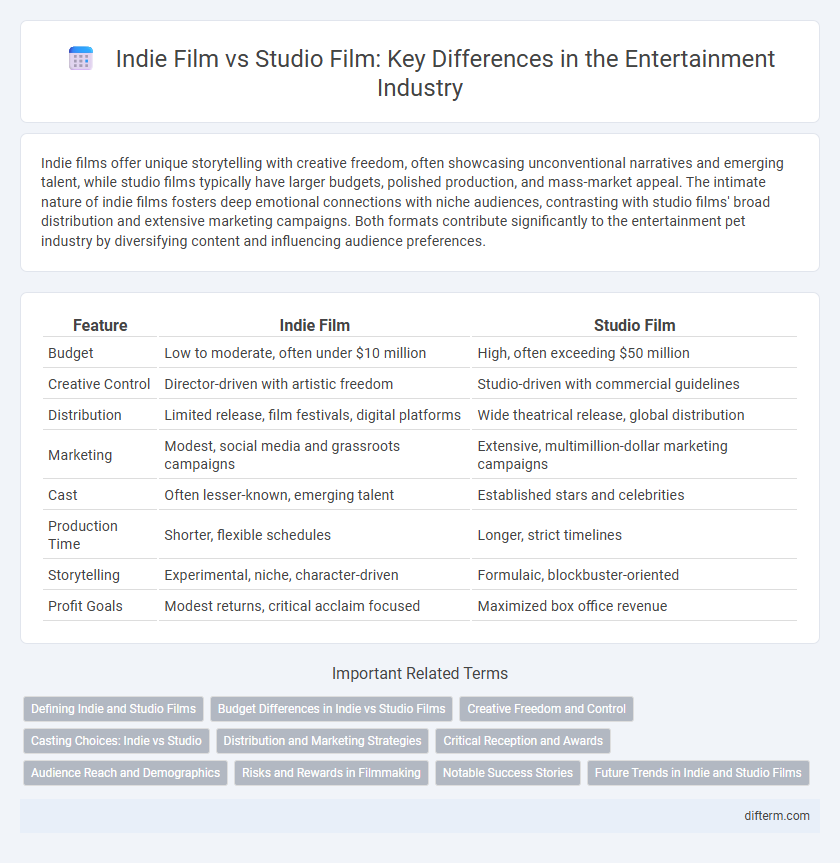Indie films offer unique storytelling with creative freedom, often showcasing unconventional narratives and emerging talent, while studio films typically have larger budgets, polished production, and mass-market appeal. The intimate nature of indie films fosters deep emotional connections with niche audiences, contrasting with studio films' broad distribution and extensive marketing campaigns. Both formats contribute significantly to the entertainment pet industry by diversifying content and influencing audience preferences.
Table of Comparison
| Feature | Indie Film | Studio Film |
|---|---|---|
| Budget | Low to moderate, often under $10 million | High, often exceeding $50 million |
| Creative Control | Director-driven with artistic freedom | Studio-driven with commercial guidelines |
| Distribution | Limited release, film festivals, digital platforms | Wide theatrical release, global distribution |
| Marketing | Modest, social media and grassroots campaigns | Extensive, multimillion-dollar marketing campaigns |
| Cast | Often lesser-known, emerging talent | Established stars and celebrities |
| Production Time | Shorter, flexible schedules | Longer, strict timelines |
| Storytelling | Experimental, niche, character-driven | Formulaic, blockbuster-oriented |
| Profit Goals | Modest returns, critical acclaim focused | Maximized box office revenue |
Defining Indie and Studio Films
Indie films are typically produced outside major studio systems, characterized by lower budgets, creative freedom, and niche storytelling often reflecting unique, personal visions. Studio films, financed and distributed by large production companies, emphasize commercial viability with substantial budgets, extensive marketing, and mass appeal targeting wide audiences. These fundamental differences between indie and studio films shape artistic choices, production scale, and audience expectations within the entertainment industry.
Budget Differences in Indie vs Studio Films
Indie films typically operate on significantly smaller budgets, often ranging from tens of thousands to a few million dollars, allowing filmmakers greater creative freedom but limiting resources. Studio films, backed by major production companies, boast multi-million to hundreds of millions dollar budgets, enabling high-end special effects, star-studded casts, and extensive marketing campaigns. Budget discrepancies profoundly influence production scale, distribution reach, and overall market impact within the entertainment industry.
Creative Freedom and Control
Indie films often provide filmmakers with greater creative freedom and control, allowing for experimental storytelling and unique artistic visions that may not align with mainstream studio expectations. Studio films typically operate under strict guidelines and commercial considerations, limiting artistic risks to ensure mass appeal and financial profitability. This balance influences how narratives are shaped, with indie projects embracing innovation and studios prioritizing market-driven content.
Casting Choices: Indie vs Studio
Casting choices in indie films often prioritize emerging talent and unique, diverse actors to create authentic, character-driven stories with limited budgets; these films embrace riskier, unconventional casting decisions. Studio films typically rely on bankable stars and established actors to maximize box office appeal and marketability, supported by extensive casting resources and industry connections. This contrast shapes the narrative styles and audience reach of indie versus studio productions, influencing the overall industry dynamics.
Distribution and Marketing Strategies
Indie films often rely on film festivals, grassroots campaigns, and targeted social media marketing to build niche audiences and generate buzz, contrasting with studio films that use extensive distribution networks and multi-channel advertising campaigns for mass market reach. Limited theatrical releases and digital platforms are key strategies for indie films to maximize visibility while controlling costs, whereas studio films secure wide releases and global marketing partnerships to ensure broad audience penetration. Understanding these distinct distribution and marketing approaches reveals how budget constraints and audience targeting shape the success trajectories of indie versus studio productions.
Critical Reception and Awards
Indie films often receive critical acclaim for their originality, artistic vision, and storytelling, frequently earning prestigious awards at festivals like Sundance and Tribeca. Studio films typically gain widespread recognition through mainstream awards such as the Oscars and Golden Globes, benefiting from larger budgets and extensive marketing campaigns. Both formats contribute uniquely to the entertainment industry, with indie films pushing creative boundaries and studio films achieving broad audience appeal.
Audience Reach and Demographics
Indie films often attract niche audiences seeking unique storytelling and diverse perspectives, appealing strongly to younger viewers and cinephiles. Studio films command broader reach with substantial marketing budgets, typically targeting mainstream demographics including families and general audiences. Audience data shows studio blockbusters dominate box office revenue, while indie films thrive in film festivals and streaming platforms catering to specialized segments.
Risks and Rewards in Filmmaking
Indie films often face higher financial risks due to limited budgets and uncertain distribution channels but can yield substantial creative rewards and critical acclaim, attracting niche audiences seeking originality. Studio films benefit from larger budgets and established marketing networks, reducing financial risk while driving significant box office returns, though they may compromise artistic innovation for broader appeal. Both models present distinct risk-reward dynamics that filmmakers evaluate based on project scope, target audience, and desired creative control.
Notable Success Stories
Indie films like "Moonlight," which won the Academy Award for Best Picture in 2017, demonstrate the potential for critical acclaim and cultural impact despite modest budgets. Studio films such as "Avengers: Endgame," which grossed over $2.8 billion worldwide, showcase the commercial success driven by large-scale marketing and established franchises. Both indie and studio films contribute significantly to the entertainment landscape through distinctive storytelling and audience reach.
Future Trends in Indie and Studio Films
Emerging technologies such as virtual reality and AI-driven storytelling are reshaping the indie film landscape by enabling lower production costs and greater creative freedom. Studio films are increasingly integrating blockbuster franchises with immersive digital experiences, targeting global markets to maximize revenue streams. Both sectors are expected to leverage streaming platforms uniquely, with indie films capitalizing on niche audiences and studios focusing on high-budget spectacle releases.
Indie film vs Studio film Infographic

 difterm.com
difterm.com